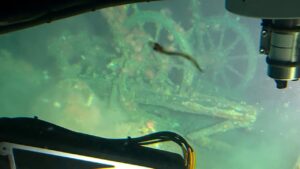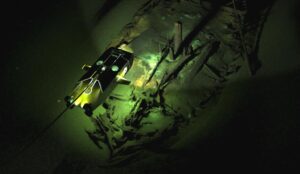In the 1950s and 1960s, the U.S. and the Soviet Union tried to turn Jules Verne’s science-fiction dream into reality.
Our planet contains many layers of different thicknesses, compositions, and overall purposes. The mantle is the thickest layer, making up 84% of the Earth’s volume. It is over 2,900km thick and sits between the core and the crust. This silicate layer drives plate tectonics, which helps creates the crust above.
Remnants of the mantle appear on the Earth’s surface in a few places around the world, such as the Tablelands in Newfoundland, Macquarie Island in Tasmania, and Barberton Mahkonjwa Geotrail in South Africa.

The Tablelands in Gros Morne National Park. Photo: Wildnerdpix/Shutterstock
The digging race begins
During the 1950s and 1960s, the U.S. and Soviet Union competed to go deeper into the Earth as well as higher into space. Both sought to dig down to the mantle and penetrate its secrets as to how the Earth formed and continues to evolve geologically. Despite the mantle’s exposure in those few locations, its physical and chemical composition change completely in open air. Erosion and weathering have also made it difficult for geologists to answer some of their most pressing questions.
U.S. attempt
During those two decades, projects to reach the mantle began. In the United States, a group of scientists known as the American Miscellaneous Society spearheaded something called Project Mohole. Its main figures included Harry Hess, one of the founders of plate tectonic theory, and Gordon Lill, an oceanographer and geophysicist.

Kola Superdeep Borehole. Photo: Andre Belozeroff/Wikipedia Commons
They wanted to drill down to recover a sample of the mantle in order to prove certain notions about plate tectonics and sea-floor spread. This sample would lie in the Mohorovičić Discontinuity, 5 to 10 kilometres below the sea floor. The Moho is the boundary between the crust and the mantle.
The National Science Foundation approved their proposal. They chose a spot off Guadalupe Island in Mexico, which had favorable geological features. Their engineers managed to drill five holes, of which the deepest measured a disappointing 183m below the sea floor. While the project acquired some volcanic samples, it suffered from a lack of unity among the stakeholders, a cut in funding, the beginning of the Vietnam War, and internal politics. It disbanded in 1966.
Soviet attempt
A few years later, in 1970, the Soviets decided to give it a go. They picked a spot on the Kola Peninsula in northwestern Russia. They drilled for over 22 years. By 1989, they had penetrated over 12km. The hole itself was a modest 23cm in diameter.
Despite the impressive depth reached, the mantle below land begins 40km down, so they still had a long way to go.
On the other hand, the Soviets managed to clear up many misconceptions about temperature and rock types at those depths. Scientists previously thought that temperatures would be around 100°C, but the hottest rocks measured 180°C. Also, they believed that the rock would be basalt, but it turned out to be granite. They kept expecting basalt to show up, but it never did.
Within the rocks, they found fossilized plankton, plant material, and most surprisingly, hydrogen gas and water. Unfortunately, the Soviets could not go on. The rock was impenetrable for the drilling equipment they were using. Before their technology could improve, the collapse of the Soviet Union ended the project.

The Japanese drill ship Chikyu. Photo: Gleam/Wikipedia Commons
Eventually, other countries decided to try. In 1987, the Germans launched the German Continental Deep Drilling Program. The main aim wasn’t to reach the mantle, but it reached nine kilometres down into the Earth’s crust, profiting from improved drilling technology.
Recent developments
In recent years, the International Ocean Discovery Program launched a massive Japanese drill ship called Chikyū. It was designed specifically to drill down and collect a sample of the upper mantle. It reached a depth of 7.7km but it did not recover anything from the mantle or Mohorovičić Discontinuity.
From 2015 to 2016, the Woods Hole Oceanographic Institution led another drilling project in the Indian Ocean. The Atlantis Banks, the region they chose, was a perfect candidate: It is a mid-ocean ridge and not as hot as other locations. Sadly, their expedition suffered many delays and a damaged drill. While it has not reached the mantle yet, the project remains ongoing.
What’s next?
The success of mega-projects like these depends on funding. The drill race in the 1960s could not have come at a worse time. The costs of the Cold War and Vietnam, and the technological limitations of the time, were simply too great. Will there ever be a revitalized interest in reaching the mantle? Sadly, the focus right now seems to be on drilling for oil and gas, the more practical treasures.






